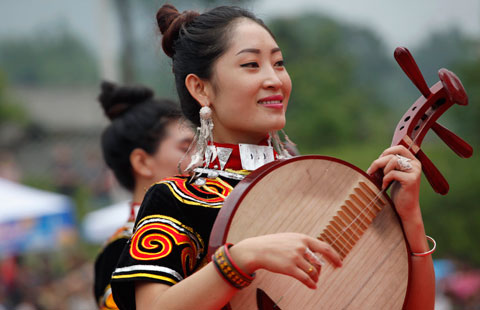New Tibetan city rises from humble start
Updated: 2014-08-18 08:13
By Hu Yongqi and Da qiongin Qamdo, Tibet(China Daily)
|
||||||||
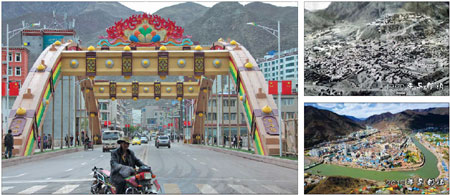 |
|
Clockwise: The newly built Chama Bridge in Qamdo township, the Tibet autonomous region, and what Qamdo looked like in 1960 and in 2012. Hu Yongqi / China Daily; File Photos Provided to China Daily |
A massive reconstruction project valued at nearly 7 billion yuan ($1.13 billion) is underway in the eastern part of the Tibet autonomous region that will eventually provide homes, neighborhoods and virtually a new city for over 1,000 families in Qamdo township.
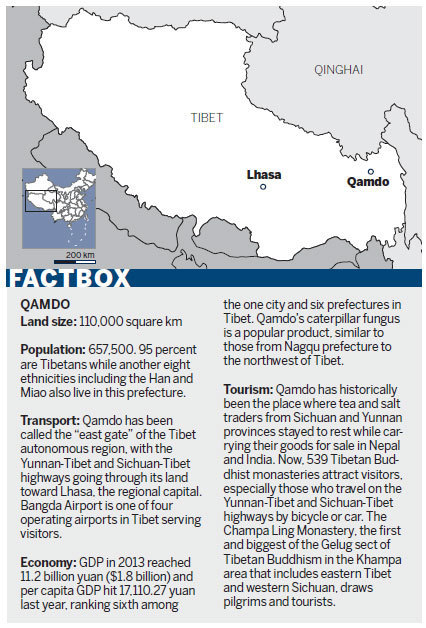
Qamdo township serves as the seat of Qamdo county, and is where the prefecture government is located. It is home to 100,000 residents, 97 percent of whom share Tibetan origins.
Helping to pay for the project is the central government and the autonomous region that will contribute about 1.53 billion yuan. A local investment company is providing 3 billion yuan. When the project is finished, the town will expand by three times to 12.6 square km to accommodate 35 percent of the prefecture's total population.
The reconstruction of this old town aims to change living conditions for the locals who haven't enjoyed high-quality infrastructure and have longed for improvements. A new city will rise from debris next year if everything goes as planned, local officials said.
Construction workers have already started to operate roaring machines to pour concrete into templates as the early morning sunlight shines over the mountains surrounding the town. Some residential complexes have risen from the ground where old and crowded neighborhoods have sustained its dwellers for decades.
As planned, about 270,000 square meters of old houses have been demolished to provide land for new apartments totaling 680,000 square meters. On the same location, the original families get a free apartment the same size as their old homes.
They are also allowed a 95 percent discount if they plan to buy another one or a shop front. Apart from these, the remaining 410,000 square meters of apartments are selling at around 4,800 yuan per square meter to fund infrastructure such as roads and a drainage system.
In ancient times, Qamdo was a stop for tea and salt traders to get some rest while plying the Ancient Road of Tea and Horse, more than 4,000 km in length. The route has served as a link between tea growers in China and drinkers in the South Asian subcontinent for more than 1,200 years.
The route has one tributary that started from the subtropical lowlands of Xishuangbanna Dai autonomous prefecture and Lincang, Yunnan province, all the way to the current Tibet autonomous region and then turning to the west to Nepal, India and Bangladesh. Meanwhile, another group of traders came in from Sichuan province. Both tributaries meet in Qamdo, then just a small town of several thousand residents.
In 1950, Qamdo was the first place that the People's Liberation Army established a station in Tibet. The county government was created nine years later. Qamdo township has two flatlands named after Yunnan and Sichuan provinces as history indicates that people from both places had a strong presence there in ancient times.
The rivers of Zachu and Ngomchu run toward the south and intersect in Qamdo, which literally means the meeting point of two rivers in the Tibetan language, to become the Lancang River that flows to Southeast Asia, and into the Mekong River. Hydropower from the rivers is also considered a growth engine for the local economy.
Qamdo prefecture, rich in more than 70 mineral reserves and agricultural resources, has been called the "East Gate of the Qinghai-Tibet Plateau".
In addition, the prefecture possesses one of four airports in Tibet and is determined to develop tourism to attract more investors.
"However, the biggest obstacle for Qamdo is the highly limited acreage of land," said Abo, head of the prefecture government. Located in between mountains and divided by the two rivers, Qamdo is eager to build taller buildings to accommodate the rising population. Reconstruction of the old town is one way to accomplish that goal.
In addition, Qamdo has an outdated infrastructure including its drainage system and fire control facilities, which make it hard to meet the demand of residents.
Many two-story houses used to be built in dense quarters, and many residents lived in houses that rarely had ventilation pipes and drainage pumps.
"The town used to be very crowded and many houses were made of wood, easy to catch fire in the dry season or when some unexpected dangers occurred," said Tsering, deputy director of the Old Town Reconstruction Office of Qamdo.
The reconstruction plan includes efforts to create amenities such as farmers' markets, parks and parking lots. About 2 billion yuan has been spent on improving infrastructure, Abo said. So far, 18 streets have been either widened or rebuilt, while five bridges are under construction to ease traffic congestion, he said.
In addition, recreational facilities, including a museum and a digital cinema, were also on the priority list to enrich the locals' lives. One promotion center also gives exhibitors a chance to strengthen the impact of the Khampa culture.
Contact the writer at huyongqi@chinadaily.com.cn
Palden Nyima contributed to this story.

 California Chinese open pockets for quake relief
California Chinese open pockets for quake relief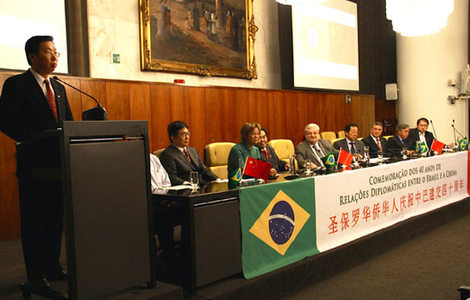
 Brazil-China a 'model' to copy
Brazil-China a 'model' to copy
 Unique relation needs further tightening
Unique relation needs further tightening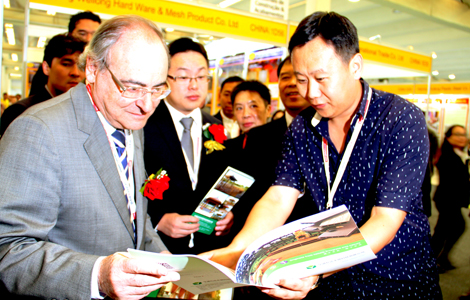
 Trade shows help firms to gain a foothold in Brazil
Trade shows help firms to gain a foothold in Brazil
 First lady tours museum with wives of foreign leaders
First lady tours museum with wives of foreign leaders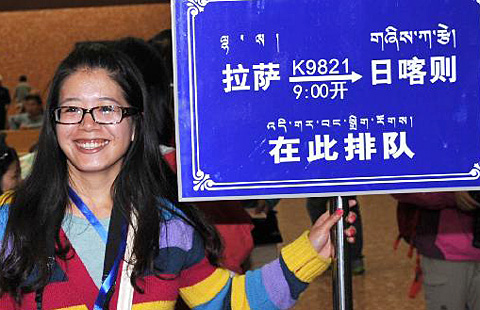
 Passenger transport starts on Tibet's new railway
Passenger transport starts on Tibet's new railway
 China to help upgrade US transport network
China to help upgrade US transport network
 Youth Olympic Games kick off in Nanjing
Youth Olympic Games kick off in Nanjing
Most Viewed
Editor's Picks

|

|

|

|

|

|
Today's Top News
190,000 people in HK turn up for anti-Occupy march
Ebola outbreak interrupts Chinese companies in Liberia
Macao's Chui unveils political platform for chief executive election
Gov declares emergency, imposes curfew in Ferguson
APEC sets ball rolling for free trade
China's holdings of US securities take a slight dip
China seeks to conduct dialogue with Vatican
China opposes Japan PM's offering to Yasukuni Shrine
US Weekly

|

|



